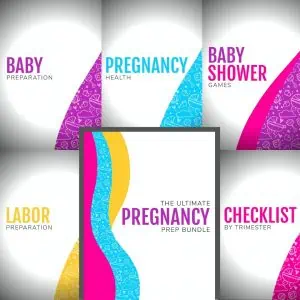Effective Breathing Techniques for Labor
This post may contain affiliate links. As an Amazon Associate, I earn from qualifying purchases.
Hey pregnant mama! As your due date is slowly approaching, it’s completely normal that you want to be as prepared for giving birth as possible. (Seriously, who doesn’t?!) Yet, you may be feeling tired and unmotivated to do all the things- I know I was. (I literally waited until I was in early labor to finally wash the last of the baby clothes and put them away- ha.)
So if you’re trying to prioritize your to-do list, I wanted to help you check off the task of knowing “how” to breathe during labor. Proper breathing is one of the most effective natural pain-relieving tools that can help you a lot during the birthing process. Seriously! 🙂 There are many specific breathing techniques for labor out there that you can practice during pregnancy.
Today, we will dive into the benefits of different breath techniques and birth mantras during labor. And we will also review some of the details of different breathing techniques for childbirth. Are you ready? Then take a deep breath and let’s get started, mama! (The fact that you’re here reading this means you’ve got this!)
Note: The most helpful resource I found for breathing techniques and practicing during pregnancy is with the KOPA Essentials Online Birth Class. It was a LIFE SAVER during my second natural birth.
Benefits of proper breathing

Relaxing and concentrating on your breathing during labor can help you enormously when it comes to the birth process. If you are wondering why then let me explain.
First of all, when you are concentrating on the way how you are breathing, it increases your focus and distracts you from pain (I recommend having a focal point to stare at too during each contraction!). Secondly, proper breathing can help you relax your muscles and mind as well. Ultimately, this can translate to a much better, positive birth experience and fewer risks for you and your little one.
Lastly, it can bring more oxygen to both you and your baby. – And believe me, you will need this extra oxygen!
Additionally, some breathing and relaxation techniques can even help reduce tearing during birth. Thus, it’s 100% worth learning a few powerful techniques, don’t you think?
When you can stay a relaxed and possible, this allows your body to do it’s thing. All your energy can go into opening that cervix without having to fight against unnecessary tension (trust me, easier said than done but oh so worth it!) In fact, did you know stress and suffering can slow your labor progression?
Related read: 11 Methods For Natural Pain-Relief During Labor
The best breathing techniques for labor
Now that you understand how you can benefit from proper breathing during labor, it’s time to review a few breathing techniques that are easy to learn yet extremely effective. Master these techniques during pregnancy and yield the best results possible when giving birth to your little one. Focusing on your breathing will also make you feel that you are in control!
I can’t stress enough the important of practicing. I did NOT do this with my first daughter. So when the time came to “breath” I had a hard time keeping my sh*t together and focusing on breathing. Whereas, with my second birth I practiced relaxation and breathing my ENTIRE pregnancy. The different was seriously night and day. Moral of the story: practice, practice, practice! You don’t want to try to learn how to breath when you’re in labor!

1. Basic deep breathing (destresser breath)
The first technique worth learning is basic deep breathing, which is also called destresser breath. Why? Because it simply eliminates stress. (Great for use when you have a button pushing toddler or teenager at home too!)
Using this technique during labor will help you decrease your pain significantly and promote a more positive birth experience. Regardless of whether you will have an unmedicated labor, get an epidural, or have a C-section, you can benefit from this basic deep breathing method a lot.
How to do the destresser breath? Breath in through your nose deeply for 4-6 seconds, and then exhale through your mouth for 6-8 seconds.
When you practice this technique, the best is if you put your hands on your belly. It can help you focus on where the air should go when you inhale (just imagine that your belly is a ballon you want to blow up). The goal is to expand your belly with each breath and deflate with each exhalation. This ensures that your baby gets an adequate amount of the much-needed oxygen.
2. Transition breathing
When your contractions become more intense, a variation of light breathing called transition breathing can help you deal with them and avoid pushing too early. Don’t forget that your cervix has to dilate enough to let the baby pass through your vagina (although- most importantly don’t forget to trust your body and it’s instincts). Thus, pushing too early means a pretty much higher chance of tearing during birth. Transition breathing is a great tool that can help you get through those moments where the intensity is picking up and you feel like your contractions are now on top of each other.
At this stage, it can be easy to feel like you’re drowning and can’t stay on top of the contractions. Focusing on your breath can take away the edge and help you ride out the intense moments until you’re finally ready to push.
To learn this technique, take 2 short shallower breaths in (hee-hee) and 2 shallow but purposeful breaths out (hoo-hoo). Make sure you’re breathes are still deep enough to keep your baby well oxygenated! I’ll admit I wasn’t a fan of this technique and continued to focus on deep breathing as much as I could.
Related read: What to Expect During Labor and Delivery for First Time Moms

3. J breath
The third technique we will review today is the “J breath”. You can use this breathing during the pushing stage to help your baby move from the womb to the outside world. I know it sounds a little bit weird that you can “breath your baby out” but it’s a super-effective technique. It can even replace the forceful pushing in some cases!
To practice J breath, inhale as fully as it is comfortable to you through your nose and exhale with a long downward breath creating a deep and low moan. When you exhale, visualize that you send the air down into the womb to the baby, then through the birth canal out the vagina in a J shape. If you watch videos of this technique, you will notice that they almost do a little mini crunch as they “push” their air downward.
Again, I’ll admit that I practiced this technique but when it came time to push I wanted that baby girl out of me and my body was telling me to push hard- so I did. Bottom line- this can be a great technique to practice and use as you listen to your body!
Birth mantras during labor
Have you ever heard of birth affirmations, aka birth mantras? Birth affirmations are simple statements or sayings that can help you transform your mindset and maintain a more positive outlook concerning birth. Usually, they are short in length so you can remember them easily.
Repeat a few positive, encouraging affirmations before and during labor to increase your self-confidence, release fear, and help you stay calm.
I understand if you find it hard to believe that repeating some statements can help you, but the effectiveness of birth mantras is backed by research. (I felt silly with my first birth- but I was totally into them with my second and it helped a ton!) A study conducted in 2016 reveals that the effectiveness of these sayings lies in neuroplasticity, the brain’s ability to change and adapt through growth and reorganization.
Imagine that these birth affirmations are powerful tools stand alone, but what if you pair them with the above-mentioned breathing techniques and other forms of pain management? The results can be enormous and reduce your need for intervention.
Make sure to write your birth mantras down on a piece of paper or in a journal far before going into labor. Thus, you will have enough time to memorize and practice them. Plus, this way you can keep these affirmations with you during labor and read them if that’s more comfortable for you.
Related read: What Is a Birth Plan? And Why You Need One
A few inspiring birth affirmations
If you need some inspiration, here are some powerful birth affirmations that can empower you during labor:
- “My body was made to do this.”
- “I am strong. I can do this.”
- “I am surrounded by lots of love and support.”
- “I take a deep breath and I stay calm.”
- “I trust myself and my capabilities.”
- “I am relaxed and I am happy to meet my baby soon.”
- “With each breath, I feel stronger and stronger.”
- “I feel good.”
- “I am present. I am doing this right now and I am happy that my baby is coming.”
- “I will have a happy birth experience.”
- “I trust my body.”
- “I breath in my courage, and I exhale my fear.”
I practiced quite a few mantras prior to labor. The ones that stuck for me were: “I am strong”, “I am calm”, “I am opening”, “I am relaxed.” At home, I also ended up saying “Just go with the flow”- inspired by a decoration in my bathroom ha.

You can do it, mama!
Although every birth experience is different and it’s hard to predict what will happen during the birth process, with proper preparation, you can do a lot to have the experience you have previously imagined. Learn some of the most effective breathing techniques for labor and empower yourself with positive birth mantras during labor. You won’t regret it!
Will you try these breathing techniques during labor? More importantly, will you practice them before labor? 🙂 Which birth affirmation did you like the most? Let me know in the comments!




